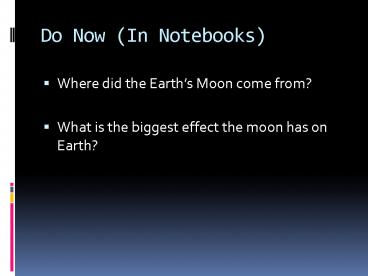Do Now (In Notebooks) - PowerPoint PPT Presentation
1 / 30
Title:
Do Now (In Notebooks)
Description:
Do Now (In Notebooks) Where did the Earth s Moon come from? What is the biggest effect the moon has on Earth? Essential Question What if there was no moon? – PowerPoint PPT presentation
Number of Views:96
Avg rating:3.0/5.0
Title: Do Now (In Notebooks)
1
Do Now (In Notebooks)
- Where did the Earths Moon come from?
- What is the biggest effect the moon has on Earth?
2
The Moon
3
- Essential Question
- What if there was no moon?
- Objectives
- Students will be able to
- Describe formation theories of the moon
- Describe how the moon affects tides
- Identify the phases of the moon
- Provide the mechanism for eclipses
- Differentiate between solar and lunar eclipses
4
Where did the moon come from?
- There are three theories of the moons formation
- Capture Theory
- Simultaneous Formation Theory
- Impact Theory
5
Capture Theory
- Moon caught by Earths gravitational pull
- Problems
- What slowed the Moon?
- Why are the compositions so similar?
6
Simultaneous Formation Theory
- Moon and Earth formed at same general time in
same general area - Problem
- Why does Earth have so much more iron?
- Why doesnt the moon have water like the Earth?
7
Impact Theory
- Earth collided with a Mars-sized object
- Materials from collision came together to form
moon - Explosion evaporated water
8
The Moons Features
- Highlands
- Areas light in color
- Mountainous
- Maria
- Dark smooth regions
- From Eruptions
- Impact craters
- Regolith
- Loose, ground up rock
- Radius - 1737.4 km
- About 1/4th of Earths
9
- How does the Moon affect us?
10
Tides
- Periodic rise and fall of the level of the ocean
- The moons gravity pulls on Earth
- Gravity creates build up of ocean water on both
near and far sides of the Earth
11
- The ocean water build up stays in line with the
moon - The ocean level rises and falls every 12 hours
12
Tidal Range
- Vertical distance between low and high tide
- 1- 2 m on East Coast of North America
- Bay of Fundy 20 meters
13
Tides
- Semidiurnal Tide
- 2 high tides and 2 low tides in 24 hours
- Diurnal Tide
- one high tide and one low tide in 24 hours
14
The Suns Effect
- Spring Tide
- When the sun and moon are aligned
- Tides are HIGHER than normal
- Neap Tide
- When the moon and sun are at right angles
- Tides are LOWER than normal
15
Sun vs. Moon
- Does the Sun or the Moon have a larger effect on
tides?
THE MOON!! Even though the moon is smaller than
the Sun, the moon is much closer to the Earth,
and therefore has a larger effect on the tides.
16
Do Now In Notebooks
- What is the most likely theory of the Moons
formation? - Draw the Sun, Earth, and Moon as they are
arranged during a neap tide.
17
Phases of the Moon
What if there was no moon?
18
What causes the moons phases?
- The moon does not emit visible light
- The moon is visible due to reflected sunlight
- One side (1/2) of the moon is always lit
- As the moon rotates around Earth, the light
reflected by the moon changes, causing phases
19
Phase Names
- Gibbous
- Crescent
- Quarter moon
- Full Moon
- New Moon
20
Waxing Vs. Waning
- Waxing
- Increase in visible, sunlit portion of the moon
- Right side of moon is visible
- Waning
- Decrease in visible, sunlit portion of the moon
- Left side of the moon is visible
21
Phase Names
- Waxing Crescent
- First Quarter
- Waxing Gibbous
- Full Moon
- Waning Gibbous
- Third Quarter
- Waning Crescent
22
(No Transcript)
23
Name the phases
24
Eclipses
What if there was no moon?
25
Eclipses
- One object moves into the shadow of another
- Named for the celestial body that is blocked
26
Lunar Eclipse
- Moon passes into Earths shadow
- Reflected light from the sun is blocked, instead
moon seems red - Can only occur during full moon
- Occur slightly more frequently than solar
27
(No Transcript)
28
Solar Eclipse
- Moon passes between Earth and Sun
- Only see outer layers of sun
- Occurs during new moon
29
Regions of Solar Eclipse
- Umbra
- Area does not receive sunlight, total eclipse
- Penumbra
- Receives partial sunlight, partial eclipse
30
Why dont we have monthly eclipses?
- The moons orbit is tilted compared to Earth
- Eclipses only occur when orbits line up































